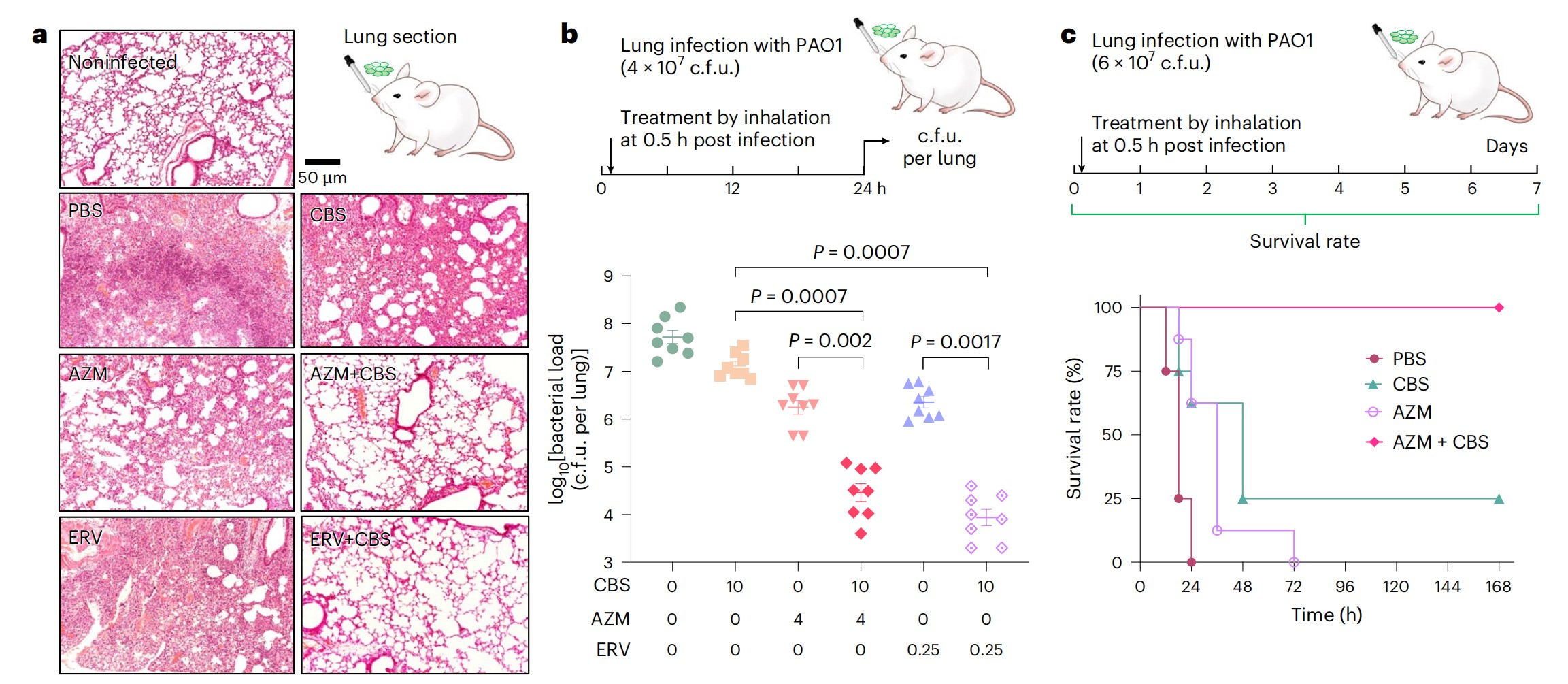08 Oct 2024
HKU Chemists Pioneer Metallodrug-Antibiotic Combination Strategy to Combat Superbugs

The combination of bismuth (Bi3+) and different types of antibiotics shows powerful synergistic antibacterial activity on Pseudomonas aeruginosa. Image adapted from the journal paper
Antimicrobial resistance (AMR) bacterial infections have become a serious problem threatening human health worldwide. The overuse of antibiotics has promoted drug-resistant mutations in bacteria, causing almost all clinically used antibiotics to develop resistance in different strains. In May 2024, the World Health Organization (WHO) updated its list of drug-resistant bacteria that pose the greatest threat to human health, among which Pseudomonas aeruginosa was listed as a high-priority pathogen. Pseudomonas aeruginosa is a particularly dangerous bacterium that can cause a wide range of infections, including pneumonia, urinary tract infections, and bloodstream infections. It is known for its ability to develop resistance to antibiotics quickly, making it challenging to treat and posing a significant risk to immunocompromised patients, such as those in hospitals or with chronic illnesses. Given the urgency of the situation, it is essential to develop new treatment strategies to combat superbug infections.
Recently, a team led by Professor Hongzhe SUN from the Department of Chemistry at The University of Hong Kong, in collaboration with the University of Groningen (Netherlands) and Nankai University, has made a breakthrough in solving this challenging problem. Their work has been published in the internationally renowned journal Nature Microbiology. The team’s work has shown the combination of different types of antibiotics with bismuth-based drugs (such as bismuth subsalicylate, commonly known as Pepto-Bismol) disrupts bacterial iron homeostasis, effectively restoring the bactericidal function of multiple antibiotics. This combination therapy leads to the elimination of multi-drug resistant bacteria Pseudomonas aeruginosa. Their efficacy has been demonstrated in both bacterial-infected cells and in mouse models, providing crucial strategies for combatting the global threat of antibiotic resistance (AMR) and offering potential clinical applications.
In a recent feature article in Nature, Professor Hongzhe Sun stated, ‘The next epidemic is likely to be an infection caused by superbugs. We must be fully prepared for it and have powerful arsenals to treat such deadly infections.’

Figure 1. The combination of bismuth (Bi3+) and different types of antibiotics shows powerful synergistic antibacterial activity on Pseudomonas aeruginosa. Image adapted from the journal paper
Research Background
Key findings
The combination of bismuth-based drugs and antibiotics has been proposed as a standard therapy for treating Helicobacter pylori infections in clinics. Sun’s team, for the first time, has applied this regimen to other multi-drug-resistant bacteria. Their study found that bismuth salicylate (Pepto-Bismol), when combined with different antibiotics, not only effectively eliminates multidrug-resistant Pseudomonas aeruginosa infections but also prevents the evolution of further antibiotic resistance. This breakthrough highlights the potential of using bismuth-based drugs alongside specific clinically used antibiotics to combat Pseudomonas aeruginosa infections, which are notoriously difficult to treat given their rapid development of resistance.
Developing new antibiotics is both costly and time-consuming, while bacteria are quickly developing resistance, shortening the lifespan of effective antibiotics. As a result, combining existing drugs synergistically is emerging as a powerful alternative to combat the rise and spread of antibiotic-resistant bacterial strains.
This study demonstrates that bismuth disrupts iron homeostasis by specifically binding to siderophore (molecules used by bacteria to obtain iron) and iron absorption regulator Fur in Pseudomonas aeruginosa. Within bacterial cells, bismuth specifically targets iron-sulfur cluster enzymes, leading to the inhibition of respiratory complexes. This disruption impairs the electron transport chain and dissipates the proton motive force. Consequently, the activity of export pumps is damaged, resulting in the accumulation of antibiotics within the bacteria and enhancing their efficacy. At the same time, this approach also enhances the killing effect of antibiotics on bacteria within the biofilm The combined treatment also demonstrated powerful antibacterial effects in the bacterial infected cell models, and the team verified the effectiveness of this therapy in over 100 strains of clinically resistant Pseudomonas aeruginosa. Finally, in a mouse lung infection model, the treatment significantly reduced bacterial colonisation in the lungs and improved the survival rate of mice. These findings lay a solid foundation for future efforts to combat drug-resistant bacterial infections and pave the way for further clinical applications.
About the research team
This study was collaboratively conducted by Professor Hongzhe Sun from the Department of Chemistry, Faculty of Science at The University of Hong Kong (HKU), Professor Oscar P. Kuipers from the University of Groningen, Netherlands, Dr Rubén Cebrián from the San Cecilio University Hospital in Granada, Spain, and Professor Weihui Wu from Nankai University. Dr Yushan Xia served as the first author.
The research team also included PhD students Xueying Wei and Chenyuan Wang, Research Assistant Professor Dr Hongyan Li from the Department of Chemistry at HKU; Assistant Professor Dr Peng Gao from the Faculty of Dentistry, HKU, and Professor Richard Yi-Tsun Kao from the Department of Microbiology at the Li Ka Shing Faculty of Medicine at HKU, along with Professor Weihui Wu from the Department of Microbiology at Nankai University. We would like to express our sincere gratitude to the Research Grants Council of Hong Kong SAR, the Health and Medical Research Fund of the Hong Kong Health Bureau, and the and Norman & Cecilia Yip Foundation of the University of Hong Kong for their generous support of this research.

Figure 2. Professor Hongzhe Sun, Chair Professor of the Department of Chemistry at The University of Hong Kong (second from right), leads a dedicated team in the battle against superbugs. This team includes (from the left) Ms Chenyuan Wang, Ms Xueying Wei, Dr Yushan Xia and Dr Hongyan Li.
About Professor Hongzhe Sun
Professor Hongzhe Sun is the Norman & Cecilia Yip Professor in Bioinorganic Chemistry and Chair Professor of Chemistry at HKU. His research focuses on metalloproteomics and metallomics, the discovery of antimicrobial agents, inorganic chemical biology and chemical biotechnology. Dr Hongyan Li is a Research Assistant Professor in the Department of Chemistry at HKU.
The journal paper can be accessed here.
‘Bismuth-based drugs sensitize Pseudomonas aeruginosa to multiple antibiotics by disrupting iron homeostasis’, Xia Y, Wei X, Li H, Cebrián R, Kuipers OP, Sun H et al, Nature Microbiology, 2024.







